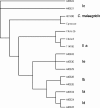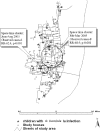Molecular and spatial epidemiology of cryptosporidiosis in children in a semiurban community in South India
- PMID: 17251402
- PMCID: PMC1829120
- DOI: 10.1128/JCM.01590-06
Molecular and spatial epidemiology of cryptosporidiosis in children in a semiurban community in South India
Abstract
Cryptosporidium spp. are a leading cause of diarrhea in Indian children, but there are no data for prevalent species or subgenotypes. Genetic characterization of Cryptosporidium spp. by PCR-restriction fragment length polymorphism and spatial analysis of cases using Geographical Information Systems technology was carried out for 53 children with cryptosporidial diarrhea in an urban slum. The two most common species were C. hominis (81%) and C. parvum (12%). Other species identified were C. felis and C. parvum (mouse genotype). Five subgenotypes were identified at the Cpgp40/15 locus. Subgenotype Ia predominated among C. hominis isolates, and all C. parvum isolates were subgenotype Ic. C. hominis infection was associated with a greater severity of diarrhea. Sequencing of the Cpgp40/15 alleles of C. felis and C. parvum (mouse genotype) revealed similarities to subgenotype IIa and C. meleagridis, respectively. Space-time analysis revealed two clusters of infection due to C. hominis Ia, with a peak in February 2005. This is the first study to demonstrate space-time clustering of a single subgenotype of C. hominis in a setting where cryptosporidiosis is endemic. Molecular characterization and spatial analysis have the potential to further the understanding of disease and transmission in the community.
Figures



References
-
- Caccio, S. M. 2005. Molecular epidemiology of human cryptosporidiosis. Parassitologia 47:185-192. - PubMed
-
- Guerrant, D. I., S. R. Moore, A. A. Lima, P. D. Patrick, J. B. Schorling, and R. L. Guerrant. 1999. Association of early childhood diarrhea and cryptosporidiosis with impaired physical fitness and cognitive function four-seven years later in a poor urban community in northeast Brazil. Am. J. Trop. Med. Hyg. 61:707-713. - PubMed
Publication types
MeSH terms
Associated data
- Actions
- Actions
- Actions
Grants and funding
LinkOut - more resources
Full Text Sources
Medical
Miscellaneous

